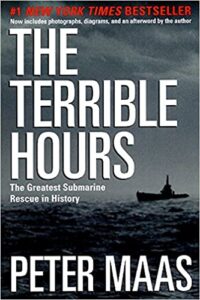Book Review | The Terrible Hours, by Peter Maas (New York: Harper Collins, 1999)
Reviewed by retired Commander Darlene Iskra, museum volunteer
 Tuesday, May 23, 1939. A day that may not live in infamy, but certainly a day, and the ensuing terrible hours, which held the nation’s attention like nothing else when USS Squalus sank off the coast of New England during test dives in preparation for her final sea trials. Built at the Portsmouth Navy Yard, the incident came at a time, at the cusp of World War in Europe, when US submarines were thought to be head and shoulders better than those German U-boats which were to play such a dramatic part of the early years of the war. To lose a new ship at this time was akin to losing face with the world.
Tuesday, May 23, 1939. A day that may not live in infamy, but certainly a day, and the ensuing terrible hours, which held the nation’s attention like nothing else when USS Squalus sank off the coast of New England during test dives in preparation for her final sea trials. Built at the Portsmouth Navy Yard, the incident came at a time, at the cusp of World War in Europe, when US submarines were thought to be head and shoulders better than those German U-boats which were to play such a dramatic part of the early years of the war. To lose a new ship at this time was akin to losing face with the world.
This non-fiction book reads like an exciting adventure novel. Although touted as a biography of Charles “Swede” Momsen, this book is primarily about the rescue and subsequent salvage of the downed submarine Squalus in 1939. Even though we know the ending of the story, of the 59 men on board, 33 were accounted for and rescued, this book is a page-turner. The hero of the story is, of course, Charles “Swede” Momsen, the inventor of the Momsen lung, and, of course, the primary person responsible for the development of the Submarine Rescue Chamber (SRC), which was used in the rescue.
Back in the early days of submarine development, the possibility of a downed submarine was considered an “acceptable risk”. After several submarines were lost in fairly shallow water in which rescue could have been successful if the technology were available, LCDR Momsen, a submariner himself, came up with the preliminary idea for the SRC. At the time, however, the Navy pooh‑poohed the idea as not feasible and rejected the proposal. The public outcry that ensued when the S‑4 went down in 1927 in 110 feet of water spurred Momsen to action.
With the help of some volunteers at the Bureau of Construction and Repair where he worked, he developed the Momsen lung, a device through which men trapped in a sub could breathe as they escaped from the sub and rose to the surface. With the success of this device, Momsen was able to resuscitate the old SRC plans. By 1939, the SRCs had been developed, but never used on an actual rescue. This would be the test.
Although the rescue of the 33 survivors was not without its problems, it went remarkably smooth, and all were safe after 39 “terrible” hours down. Even more exciting, and dangerous, however, was the salvage of the boat itself. It was imperative to discover the cause of the sinking, as new submarines of that class were still being built. The salvage took approximately 110 days, but what was accomplished in that time was a feat of courage, strength, skill and perseverance. The Squalus was sitting on the bottom at 243 feet. At that depth, divers breathing air are invariably overcome by nitrogen narcosis, a potentially dangerous condition that results in loss of concentration, confusion, and ability to function. A helium‑oxygen mixture for diving in deeper water was just being developed, again by Momsen, and by the summer of 1939, was ready for testing. As it turned out, Squalus was the test platform for this new technology as well.
Every salvage job has its quirks because each ship will have different problems that have to be worked out. A plan that sounds good on the surface, will have to be revised several times. Something that takes two minutes on the surface can, and does, take several hours and numerous dives to the bottom. Equipment breaks, malfunctions, or changes in the list and trim of the ship cause potential calamities. And the weather, of course, is always a concern.
The remainder of the book almost seemed like a postscript as it described the rest of Momsen’s naval career. Momsen continued to serve the Navy during WWII with his innovative ideas, and finally retired in 1955 as a vice admiral. The most disappointing part about the book was its lack of pictures and diagrams. It would have helped a great deal to visualize the extent of the effort involved, what the diving gear, SRC, and salvage pontoons looked like, how the SRC mated to the submarine, and a sketch on how the pontoons were rigged. A photo of Momsen would have been nice, too. All in all, it was a great read, highly recommended for salvors, divers, and everyone who ever went to sea in ships, or in the easy chair of their living room.
